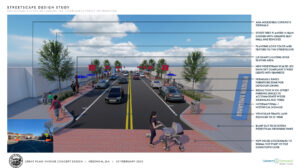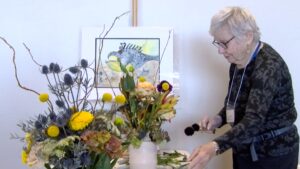
A New Day for GPA?
March 1, 2024
• Great Plain Avenue is one of the most prominent roads in downtown Needham. The Select Board is now looking for a partner to help reimagine what it could be.
Is Needham ready for one-lane travel down Great Plain Avenue?
Following a request for proposals, three of four responding prequalified firms presented their conceptual plans for the future of Great Plain Avenue. All plans so far reduced the street’s two lanes down to one. The current effort started when the Department of Public Works met with the Select Board last year to discuss redesigning Needham’s downtown, DPW Director Carys Lustig said.
The RFP tasked the engineering firms to address the “many deficiencies” of the Great Plain Avenue area, which “provides the backbone of the downtown area.”
“Creativity and vision are encouraged as part of this process as the Town seeks to reimagine the Downtown,” the RFP states.
The town offered up to $5,000 for each firm — by request — to create a more detailed submission than required in a typical RFP process. That money comes from Chapter 90 funds, Communications and Community Engagement Director Amy Haelsen told Needham Local.
The resulting proposals emphasized the different approaches of the competing firms.
Community Consensus
“A more vibrant and multimodal downtown” may be in Needham’s future, according to Eileen Gunn, client manager and complete streets advisor at Fuss and O’Neill.

In their research, Gunn said they determined locals would like the town to feel like a village, be safe, limit traffic, “generate economic vitality” and attract non-Needham residents. The big trade-off, however, is working within a limited space.
All four of their conceptual designs reduced Great Plain Avenue’s two lanes down to one with a parking lane on either side of the road. Two of the cross-sections included bike infrastructure, another included an additional turn lane and one displayed a larger sidewalk zone for potential outdoor dining.
Ian Law, who works in landscape architecture, urban planning and downtown vibrancy for the firm, explained their intensive two-day community design charrette, wherein they garner feedback from residents who help them efficiently reach a consensus on the project.
That process involves a “public walk and talk,” a public visioning workshop and, after ascertaining residents’ top two designs, another presentation of conceptual drawings designed to gauge further community input, Ian Law said.
Fuss and O’Neill’s Arnold Robinson explained that “community engagement is at the heart of what we do.”
“The best projects happen when you’re sitting down with professionals designing together, hearing needs together, prioritizing things together for the community,” Robinson said.
The firm is currently working on Dedham Avenue, where construction is expected to begin this summer, as well as on Webster Street, Project Manager Matthew Skelly said.
During the presentation, leaders explained they would be cognizant of other ongoing projects, including the MBTA Communities Law implementation, and are incorporating bottleneck reduction. Heat reduction and stormwater management will also be topics of conversation.
On the process, Robinson explained the hard work and dedication required for such a project, but it’s one that reaches a satisfying conclusion.
“It’s messy, it’s hard, you’re engaging a lot of different people, but in the end, when you get to Town Meeting for the vote, everybody’s with you,” Robinson said. “They understand it and they can vote yes, and they can get there and understand that.”
A ‘Bold Vision’
Conrad Leger, principal at Environmental Partners, asked the Select Board to participate in a visualization exercise. He displayed a photo of the intersection of Great Plain Avenue, Chestnut Street and Chapel Street and asked them to close their eyes and picture what the space may become.
Afterward, Leger posed a question.
“What’s the difference between those visions and what’s on screen? The answer is people,” he said. “People are going to enjoy outdoor dining, people are going to want to cross that street safely, people are going to ride bikes and people are going to enjoy that Town Common. People make spaces vibrant. With that, our interpretation of your vision is people-focused and people-centric.”
As it stands now, the corridor is “very vehicle-centric,” he said, and in partnership with Toole Design Group, the firm hopes to institute placemaking, green infrastructure and safety for all modes of transit.

Margot Schoenfelder, the project manager at Environmental Partners, shared their “bold vision”: a one-lane street with individual one-way bike lanes. The street would be flanked by sidewalks, a sidewalk buffer with trees and a parking lane. Placemaking, pedestrian accommodations and traffic-calming were identified as top priorities.
As part of the process, Schoenfelder said they would involve the community in engagement activities, as they have done in a Newton Highlands redesign — the team encouraged residents there to place different design elements onto a board in an effort to illustrate the limitations of a space.
They plan to “encourage collaboration” through a design charrette, open houses and small group conversations, she said, which all allow for all community members to provide input. The project team also expressed interest in involving local artists and cultural groups as stakeholders to integrate placemaking into the design and help identify what sets Needham apart.
“The space is so dominated by pavement right now that we really feel like reallocating some of that space to places that can be enjoyed by non-motorists is step one in bringing people to the downtown more,” Schoenfelder said.
While traffic is an important consideration, for Karen Fitzgerald — the director of landscape architecture at Toole Design Group — it’s also about getting people out of their cars and allowing the space to serve as more than a traffic pass-through.
“We want a lot of people walking around here, feeling comfortable, being able to cross back and forth from one side to the other. Looking at shorter crossings would be something that we would encourage,” Fitzgerald said, “as well as pedestrian amenities that really enhance the experience of being downtown and just bring joy into wanting to come down here and hang out and meet your friends and gather.”
At the end of the presentation, Vice Chair Kevin Keane, who served as chair of the meeting, reflected on the firm’s messaging.
“You all asked how bold we want to be. I’d say very bold,” Keane said. “I would love to see some real good reimagining.”
A Look at Concord
For what Needham’s downtown could become, look to Concord, N.H., Weston and Sampson said.
Several of the firm’s current team members collaborated on a Concord Main Street revitalization with a previous firm, which Project Manager and Lead Designer Johnathan Law described as “transformative.”
What once was just a four-lane highway that posed a safety risk and lacked dining space, greenery and tenants looks very different now. After reducing the road diet, planting dozens of trees, increasing the sidewalk width and more, the redesign became a “catalyst for downtown Concord,” Johnathan Law said.

“And Needham is not struggling like Concord was, but what this project did is it brought future development to some of the vacant spaces in downtown, there was a new hotel opened,” he said. “It was a catalyst for further regeneration to this area, and future regeneration is good for any town and city, whether it’s booming or not.”
For Needham, Weston and Sampson proposes a single lane of travel in both directions, a parking lane, sidewalk buffer and widened sidewalks. Unfortunately, the buildings themselves can’t move, Johnathan Law said, meaning there will be compromises, which, in this case, means traffic lanes will be reduced. The plans did not include a bike lane.
That, however, makes room for other possibilities. Monumental signage on sidewalks can contain historical information on the neighborhood or businesses in the area. They also aim to include the DPW in partnership, including on how snow plows would move through the street.
Transportation Practice Leader Jeffrey Santacruce shared certain elements from the Concord Main Street project, including the pedestrian-level signage, ADA compliance and flush cobblestone median, which can serve as turn lanes as well as parking spaces for large vehicle deliveries.
Alyssa Peck, the firm’s project manager, said the group has worked with Needham for more than 30 years.
Pointing to one of their conceptual designs depicting outdoor dining at night outside of Comella’s, Johnathan Law mused about the space and its ambiance.
“I mean, I’m already eating a slice of pizza on that table,” he said.
Another firm, GPI, will present its own visions at the board’s March 12th meeting. There is a selection committee composed of town staff, Lustig said.
The town expects to award the design contract to one of the four firms this month, according to a timeline included in the RFP, and will look to acquire project funding at Town Meeting in May 2025. If all goes to plan, construction should begin in August of next year and is expected to take two years.

